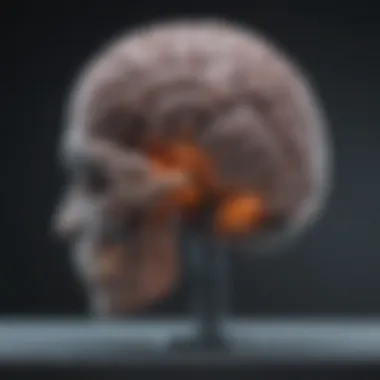Understanding Head Injuries from Falls Down Stairs


Intro
Head injuries from falls, particularly down stairs, present a critical issue within the field of health sciences. Each year, countless individuals experience accidents resulting in varying degrees of head trauma. Understanding the nature and implications of these injuries assists in both immediate response and long-term care.
This article systematically explores the multifaceted aspects of head injuries sustained from stair falls. By examining definitions, types, symptoms, treatments, and preventive measures, it provides valuable insights for students, researchers, and health professionals aiming to enhance their knowledge and improve safety protocols. Insights drawn from established research and practical scenarios will contribute to a more thorough comprehension of this significant public health concern.
Intro to Head Injuries
Head injuries are complex phenomena, especially in the context of falls, such as those that occur down stairs. This section aims to establish an essential framework for understanding head injuries by defining them and emphasizing the relevance of their study.
Defining Head Injuries
Head injuries encompass a wide range of traumas affecting the skull and brain. They can be classified into various types, such as concussions, contusions, and fractures. Collectively, these injuries result from any impact, jolt, or force transferred to the head, leading to potential short-term or long-term effects.
The classification extends to both closed injuries, where the skull remains intact, and open injuries, involving a break in the skull. Symptoms can vary greatly, with some injuries presenting immediate signs, while others may evolve gradually. This variability underscores the need for clear definitions and categories in discussing head injuries, allowing medical professionals to develop better preventive and treatment strategies.
Significance of Studying Head Injuries
The study of head injuries from falls carries profound implications. An estimated 1.7 million individuals in the United States sustain traumatic brain injuries annually, highlighting the urgent need to understand the dynamics of these incidents. Falls down stairs are a significant contributor to this statistic, affecting individuals of all ages, though the elderly often suffer disproportionately due to reduced mobility and balance.
Investigating head injuries helps in several ways:
- Improvement of Treatment Protocols: Understanding common injury patterns can lead to advancements in immediate care and rehabilitation methodologies.
- Development of Preventive Strategies: Analyzing causes assists in creating awareness and safety measures, ultimately reducing the incidence of such accidents.
- Enhancement of Policy Making: Data-driven insights inform policymakers aiming to regulate public spaces, ensuring better safety standards in buildings and homes.
"A comprehensive grasp of head injuries is not merely academic; it shapes our collective ability to prevent and treat one of the most critical health issues of our time."
As we explore this topic further, a closer examination of the various mechanics involved, types of injuries incurred, and the implications on health will be established. This insight will benefit students, researchers, and health professionals alike, fostering a more profound understanding of head injuries resulting from falls.
The Mechanics of Falling Down Stairs
Understanding the mechanics of falling down stairs is essential in addressing head injuries related to such incidents. This section sheds light on the various factors involved in these falls, focusing on dynamics and common causes. By grasping these elements, researchers, health professionals, and the general public can better understand risks connected to stair falls.
Understanding the Dynamics of Falls
Falls down stairs can result from a combination of environmental and personal factors. The dynamics of a fall involve several aspects:
- Gravity: The force of gravity plays a fundamental role in stair falls. When an individual loses balance, gravity accelerates the fall, increasing the risk of sustaining severe injuries.
- Body Position: The way a person falls can also influence injury outcome. Falling forward, backward, or to the side can result in different impact patterns on the head.
- Momentum: The speed at which a person is moving when they begin to fall determines the energy released on impact. Higher speeds can lead to more severe injuries.
In research, biomechanics—the study of body movements—provides insight into how forces interact during a fall. Understanding these dynamics is crucial in developing safety measures and injury prevention strategies.
Common Causes of Stair Falls
Identifying causes of stair falls helps in reducing their occurrence. Some factors that contribute to these incidents include:
- Poor Lighting: Inadequate lighting can obscure steps, making it challenging to navigate safely.
- Hazardous Surfaces: Slippery surfaces, whether due to spills or weather conditions, can lead to unexpected falls.
- Improper Handrail Use: Not using handrails reduces stability and increases fall risk.
- Distractions: Engaging with a mobile device or conversing can distract individuals, leading to missteps.
- Physical Limitations: Older adults or those with mobility issues often face heightened risks due to decreased balance and strength.
By understanding these common causes, stakeholders can develop targeted interventions to mitigate risks associated with falling down stairs.
"Recognizing the causes and dynamics of stair falls can lead to better safety implementations in homes and public spaces, ultimately saving lives."
Addressing the mechanics of falling down stairs serves as a foundation for comprehending the subsequent types of head injuries, symptoms, and treatment options that follow these incidents.
Types of Head Injuries


Understanding the types of head injuries that can occur from falling down stairs is crucial for multiple reasons. Medical professionals need to distinguish between these injuries to provide effective treatment. The differing nature, severity, and potential complications of each head injury type affect both immediate care and long-term management. This section will clarify the types of head injuries that may result from such accidents, drawing attention to the inherent risks and the importance of recognition and response.
Concussions and Mild Traumatic Brain Injury
A concussion is a form of mild traumatic brain injury (mTBI) that often occurs due to impacts or falls. The sudden motion of the brain inside the skull causes temporary impairment. Symptoms of concussions include headache, confusion, dizziness, and sometimes loss of consciousness. In stair falls, even a minor bump can trigger a concussion.
The following points highlight critical aspects of concussions:
- Detection: Quick identification is essential. Symptoms may not appear immediately, making it vital to monitor the individual closely.
- Recovery: Most people recover completely, but rest and gradual return to activities are necessary.
- Repeated Injuries: Subsequent concussions can lead to cumulative damage, increasing the risk for more serious conditions.
Contusions and Lacerations
A contusion, or bruise, occurs when blood vessels break due to trauma. In the context of a fall, a person may experience contusions on the scalp or other parts of the head. Lacerations, on the other hand, refer to cuts that may occur in the skin or surrounding tissues. Both injuries may range from superficial to deep, requiring varying treatment approaches based on their severity.
Key considerations for contusions and lacerations include:
- Assessment: It is important to evaluate the extent of the injury. While a superficial bruise may need little intervention, deep lacerations might require stitches or surgical care.
- Infection Risk: Cuts carry a risk of infection. Proper cleaning and monitoring for signs of infection are vital.
- Signs of Complications: If a contusion leads to swelling or changes in consciousness, further medical evaluation is necessary.
Skull Fractures
Skull fractures are among the most serious injuries associated with falls. Such fractures can range from simple cracks to more complex breaks that may involve fragments pressing into brain tissue. Symptoms can vary widely and might include a visible deformity, severe headache, or even neurological deficits.
Considerations for skull fractures include:
- Emergency Care: Immediate medical attention is needed if a fracture is suspected. Imaging techniques, such as CT scans, are often utilized to assess the severity.
- Complications: These can include bleeding, brain injuries, and infections. The management would involve thorough monitoring.
- Surgery: In some cases, surgery may be necessary to relieve pressure or repair the skull.
Important Note: Recognizing the type of head injury sustained after a fall can dramatically affect treatment outcomes. Every injury must be taken seriously, regardless of how minor it may seem at first.
Symptoms of Head Injuries from Stair Falls
Recognizing symptoms following a head injury from a stair fall is vital for ensuring appropriate care and recovery. Identifying these symptoms promptly provides a chance for timely intervention. This section examines both immediate symptoms that arise after the fall and long-term complications that may develop. Understanding these elements can significantly influence the outcome for the affected individual, highlighting the importance of awareness in such incidents.
Immediate Symptoms to Recognize
Head injuries can manifest through a variety of immediate symptoms. These may arise within moments following the trauma, necessitating quick attention. Some common immediate symptoms include:
- Headache: A common response to trauma, headache intensity can vary. It is essential for victims to express their discomfort.
- Confusion or Disorientation: Individuals may find it difficult to remember the event or their surroundings. This confusion can indicate a more severe injury.
- Nausea or Vomiting: These symptoms often accompany head injuries. Persistent vomiting is particularly concerning and requires evaluation.
- Dizziness or Balance Issues: Affected individuals may feel unsteady, often leading to difficulty in walking or standing.
- Altered Consciousness: Losing consciousness, even for a brief period, is an alarming sign. It signifies potential underlying trauma to the brain.
Recognizing these symptoms promptly can help in making informed decisions regarding medical attention. If any of these signs are evident, seeking a healthcare professional is vital.
Long-term Symptoms and Complications
Long-term effects from head injuries sustained during stair falls can be profound. In some cases, immediate symptoms may resolve, but underlying complications could emerge later. Key long-term symptoms include:
- Cognitive Changes: Individuals may experience issues with memory, attention, and problem-solving. These changes can affect day-to-day life significantly.
- Mood Disorders: Emotional disturbances, such as depression and anxiety, could arise. These are often overlooked but can impact recovery and quality of life.
- Chronic Headaches: Post-traumatic headaches may persist long after the initial injury. These headaches can become a frequent disruption.
- Physical Challenges: Difficulties with balance, coordination, and fine motor skills can arise years after the injury, impacting normal activities.
- Seizures: Some individuals may develop seizures as a result of their head injury, which warrants ongoing medical evaluation.
"Understanding the potential for long-term symptoms is crucial. Early detection and management can improve recovery outcomes."
It is essential for individuals who have suffered a head injury to monitor their health over time. Regular follow-ups with healthcare providers can help in managing any complications that may develop. Awareness of these symptoms assists in fostering a better understanding of recovery and ensuring that individuals receive the support they need.
Diagnosis of Head Injuries
Diagnosis of head injuries resulting from falls down stairs is a critical aspect that influences both treatment and recovery. It ensures timely intervention, significantly lowering the risk of complications. Understanding head injuries requires an accurate assessment, particularly given the complexity of symptoms and the potential for serious outcomes. Professionals must take a detailed history and physical examination to identify the specific injuries sustained.


Early diagnosis is vital for effective management. In many cases, head injuries may not present with obvious symptoms immediately after the event. Symptoms can take hours or even days to manifest. Therefore, the role of healthcare providers is to be thorough in evaluating the patient’s condition. This can include assessing factors such as consciousness, cognitive abilities, and physical capabilities. With proper diagnosis, healthcare professionals can devise an appropriate treatment plan tailored to the individual’s needs.
Clinical Evaluation Procedures
Clinical evaluation procedures involve a multi-faceted approach to gather comprehensive information about the patient’s condition. Initially, medical professionals often use the Glasgow Coma Scale (GCS) to assess the level of consciousness. The GCS score aids in gauging the severity of a head injury.
Key components of the clinical evaluation include:
- Patient History: Gathering details about the incident, previous injuries, and any medical history related to head trauma.
- Neurological Examination: Testing reflexes, motor functions, and sensory responses. This step is crucial for identifying any abnormalities or deficits.
- Cognitive Assessment: Simple tasks may be employed to evaluate memory and problem-solving abilities. Any confusion or disorientation should be noted.
- Physical Examination: Checking for external injuries, swelling, or signs of trauma to the head or neck.
This evaluation helps determine further actions. It identifies whether imaging studies are necessary or if immediate intervention is required.
Imaging Techniques Used
Imaging techniques are essential for diagnosing the extent of injuries that may not be evident from the clinical evaluation alone. These techniques provide visual insight that can aid in understanding the internal injuries sustained during the fall.
Common imaging modalities utilized include:
- Computed Tomography (CT) Scan: This is often the first-line imaging method for head trauma. It quickly identifies fractures, bleeding, and other serious injuries.
- Magnetic Resonance Imaging (MRI): While not as commonly used for acute cases, MRI is useful for detailed visualization of the brain structures and can be used later to assess ongoing complications.
- X-rays: While not routinely used for soft tissue injuries, X-rays can help identify skull fractures in certain circumstances.
Utilizing these imaging techniques not only confirms the presence of injuries but also assists in making informed decisions regarding treatment pathways. Accurate interpretations of these scans by trained professionals are necessary, as misdiagnoses can lead to improper treatment and prolonged recovery periods.
"An accurate diagnosis of head injuries is fundamental to reducing morbidity and guiding effective management strategies."
Treatment Options for Head Injuries
Understanding treatment options for head injuries, especially those resulting from falls down stairs, is essential for effective care and recovery. The path from initial injury to rehabilitation can greatly affect outcomes and quality of life. Timely and appropriate treatments can minimize complications and promote recovery, making this topic highly relevant for anyone dealing with or studying head injuries.
Emergency Response and First Aid
When someone suffers from a head injury after falling down stairs, immediate response plays a crucial role. First responders must assess the situation before acting. It is vital to ensure the environment is safe to prevent further injury. Here are some key steps for emergency response:
- Call for Help: If the injured person is unresponsive or showing severe symptoms, calling emergency services is crucial.
- Assess Consciousness: Check if the person is conscious and responsive. Speak to them and try to gauge their awareness.
- Control Bleeding: If there is visible bleeding, gently apply pressure with a clean cloth to control it while waiting for medical help.
- Avoid Movement: Keep the person still to prevent further injury. Movement can exacerbate possible spinal injuries.
- Monitor Symptoms: Keep an eye on their breathing and responsiveness. Note any changes in their condition for medical personnel.
These first aid measures can stabilize the person and provide critical information for EMS upon arrival.
"Timely first aid can be a vital link in the chain of survival for individuals with head injuries."
Medical Interventions and Rehabilitation
After stabilization, medical interventions may include diagnostic imaging and treatment tailored to the type and severity of head injury. Common approaches include:
- CT or MRI Scans: Imaging is crucial for identifying brain injuries, skull fractures, or internal bleeding. This helps in developing an accurate treatment plan.
- Medications: Pain relief is often necessary. Doctors may also prescribe medications to reduce swelling or manage symptoms like seizures if applicable.
- Surgery: In severe cases, surgical intervention may be required to repair fractures, relieve pressure from swelling, or treat other complications.
- Rehabilitation: Post-treatment, rehabilitation can take many forms. Physical therapy focuses on restoring movement, while cognitive therapy addresses any cognitive impairments caused by brain injuries. Occupational therapy may assist the patient in returning to daily activities.
These medical interventions and rehabilitation strategies are critical in ensuring a comprehensive recovery plan. Each person’s treatment plan should be individualized, taking into account their specific needs and circumstances.
In summary, understanding treatment options for head injuries offers valuable insight into effective management and recovery pathways. Both emergency response strategies and medical interventions are vital in shaping outcomes for individuals who have experienced falls down stairs.
Psychosocial Aspects of Recovery
The psychosocial aspects of recovery after a head injury from falling down stairs play a crucial role in the overall healing process. An individual's mental and emotional state can significantly influence their physical recovery and quality of life. This section delves into the effects of such injuries on mental health, the coping mechanisms available to patients, and the importance of supportive environments.
Impact on Mental Health


Head injuries, particularly those sustained from falls, can lead to a range of mental health issues. Patients may experience anxiety, depression, or post-traumatic stress disorder (PTSD) following their injury. These conditions can arise due to various factors, including the sudden change in lifestyle, loss of independence, or even the fear of future falls.
Recognizing Mental Health Challenges
It is essential for caregivers and health professionals to recognize these mental health challenges early. Signs can include:
- Persistent sadness or low mood
- Irritability or mood swings
- Difficulty concentrating or processing information
- Withdrawal from social activities
Such symptoms not only impact day-to-day living but can also hinder physical recovery from the injury. Consequently, establishing a holistic approach to recovery is vital, integrating both physical rehabilitation and mental health support.
Coping Mechanisms for Patients
For those recovering from head injuries, implementing effective coping mechanisms can greatly enhance their mental well-being. Several strategies can be beneficial:
- Engagement in Support Groups: Connecting with others who have faced similar experiences can diminish feelings of isolation and provide emotional support.
- Mindfulness and Relaxation Techniques: Practices such as meditation, deep breathing, or yoga can reduce stress and promote a sense of calm.
- Structured Rehabilitation Programs: A better-organized approach to rehabilitation can facilitate progress, offer a sense of control, and improve confidence.
- Professional Counseling: Seeking assistance from psychologists or therapists trained in trauma care can help address deeper emotional impacts.
"Having a strong support network and effective coping strategies can make a significant difference in the recovery journey for head injury patients."
As individuals navigate the complexities of recovery, focusing on both physical and psychological needs creates a comprehensive path toward healing. Encouraging a positive outlook and fostering resilience can empower patients. This dual approach includes emotional understanding and practical support, ultimately aiding the transition back to daily life.
Preventive Measures Against Stair Falls
Falls down stairs are common and can lead to significant head injuries. Implementing preventive measures is crucial in minimizing these risks. Effective strategies focus on modifying the environment and educating individuals about safe practices. Both aspects work together to reduce the likelihood of accidents. Understanding these preventive measures is essential for health professionals, caregivers, and anyone concerned with safety.
Home Safety Modifications
Making modifications in the home can greatly enhance stair safety. Here are key steps to consider:
- Install Handrails: Handrails should be installed on both sides of the stairs. They provide support for anyone using the stairs.
- Proper Lighting: Ensure all stairways are well-lit. This includes using light bulbs that are bright enough and having light switches at both the top and bottom of the stairs.
- Non-Slip Strips: Applying non-slip strips to the edges of each step can prevent slipping, especially on bare wood or tiled stairs.
- Clear Obstacles: Regularly check the staircase for any obstacles, like shoes or other items that can cause tripping.
- Sturdy Carpeting: If carpeting is used, it should be secured properly to avoid movement that can cause falls.
These modifications not only enhance safety but also reassure inhabitants. Older adults and children are especially prone to falls, so maintaining a safe environment can significantly reduce hazards.
Education and Awareness Programs
Education is equally important in preventing stair-related injuries. Programs must focus on raising awareness about safe stair practices. These initiatives can operate in various contexts:
- Community Workshops: Organizing workshops that teach proper stair usage and safety practices can be effective. Information should cover the importance of using handrails and being attentive while on stairs.
- School Programs: Schools can implement programs that educate children about stair safety. Engaging activities can be practical, making the information easier to understand and remember.
- Online Resources: Providing access to online materials and resources enables a wider audience to learn about stair safety. Videos and articles about safe behavior on stairs can be very informative.
"Most injuries can be prevented with simple changes in behavior and environment."
While home modifications play a role, education ensures that individuals are aware of potential risks. Together, these preventive measures form a comprehensive approach to reduce the incidence of head injuries from falls down stairs.
The End and Future Directions
Key elements discussed include the various types of head injuries, immediate symptoms, long-term effects, and treatment options. Each section builds a comprehensive picture that emphasizes the ongoing need for awareness and proactive measures. For learners and professionals, grasping these concepts is essential.
"Effective communication about head injuries can save lives and improve recovery outcomes."
Additionally, examining psychosocial aspects contributes to understanding recovery beyond physical treatments. Mental health repercussions are often overlooked but critical in designing effective rehabilitation programs. This holistic approach enriches the overall comprehension of head injuries.
Future research is necessary to refine prevention techniques and enhance treatment protocols. As new data surfaces, identifying at-risk populations and effective educational initiatives is crucial. Integrating findings from diverse disciplines may yield actionable insights.
In summary, continued exploration of the topic ensures advancements in both understanding and management of stair-related head injuries. Engaging with this field fosters innovations that will improve health outcomes and safety measures moving forward.
Summary of Key Points
- Head injuries from stair falls are complex and multifaceted.
- Understanding types of injuries (concussions, contusions, fractures) is essential for diagnosis and treatment planning.
- Awareness about immediate symptoms can lead to prompt care, reducing complications.
- Holistic views on recovery include both physical rehabilitation and mental health support.
- Future research should focus on prevention and new treatment modalities.
Areas for Further Research
- Investigating Long-term Consequences: There is a need for studies that track patients after recovery to understand the broader implications of head injuries over time.
- Developing Advanced Safety Protocols: Expanding research on how architectural design can minimize risks associated with stair usage.
- Psychosocial Impacts: Further exploration into how head injuries affect mental health and recovery timing can inform clinical practices.
- Educational Effectiveness: Evaluating the effectiveness of educational programs on preventing falls and managing injuries could yield valuable data.
- Emerging Technologies in Treatment: New technologies in imaging and rehabilitation deserve attention for their potential in transforming patient care.







